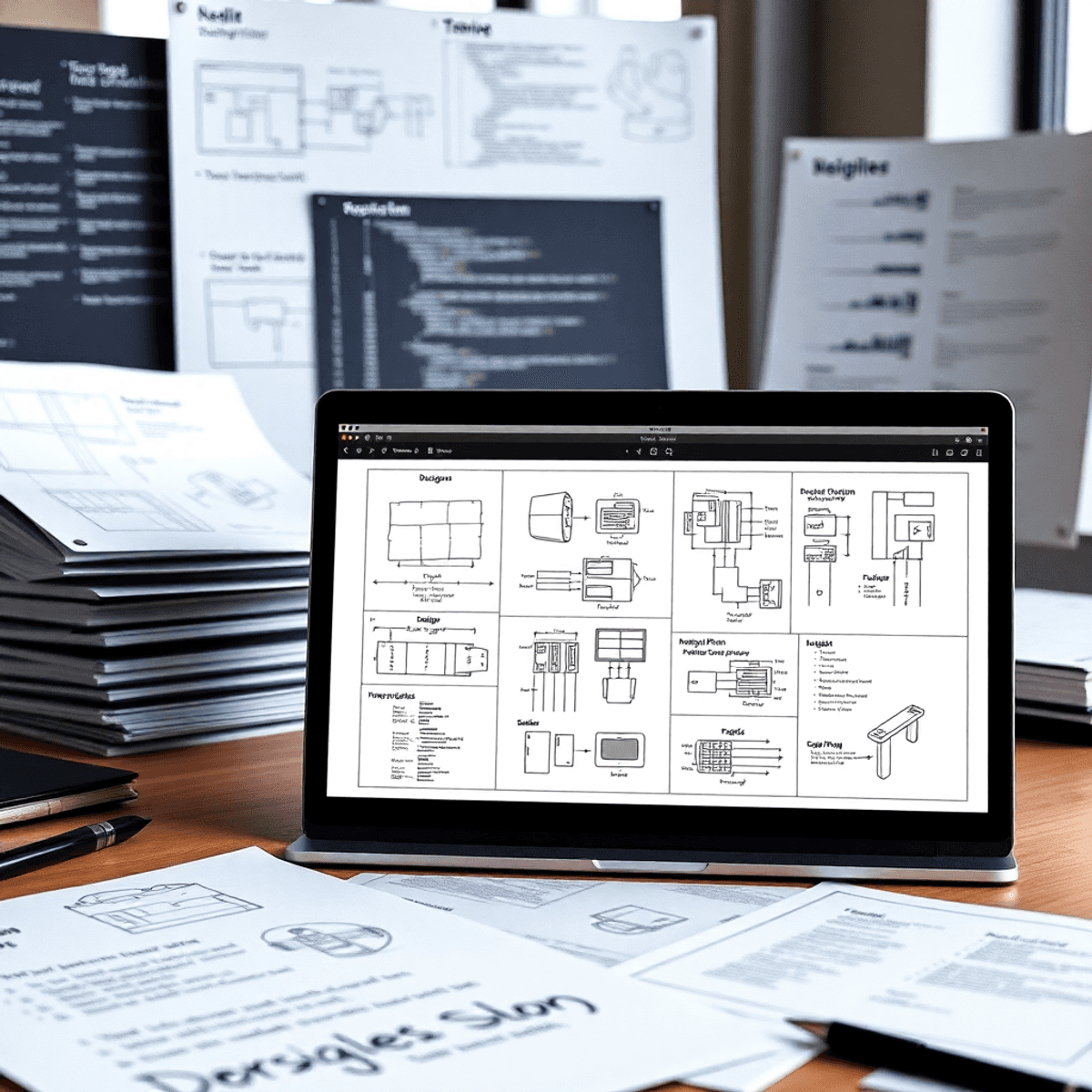The Custom Software Development Lifecycle (SDLC) is the backbone of successful software creation in 2025. This systematic approach transforms raw ideas into powerful, tailored solutions that address specific business challenges.
Think of SDLC as your roadmap – a structured journey that guides you through each critical phase:
- Idea Analysis: Validating your concept against market needs
- Research: Gathering requirements and exploring technical possibilities
- Design: Creating user-friendly interfaces and experiences
- Development: Building the actual software solution
- Testing: Ensuring quality and reliability
- Deployment: Launching your solution effectively
- Maintenance: Supporting and evolving your software
In 2025’s fast-paced digital landscape, understanding this end-to-end process isn’t just helpful – it’s essential. Businesses and developers who master SDLC gain:
- Reduced development risks
- Better resource allocation
- Clearer project timelines
- Higher quality end products
- Improved stakeholder satisfaction
The modern SDLC integrates cutting-edge technologies like AI, blockchain, and IoT while maintaining focus on user needs and business objectives. This balance between innovation and practicality ensures your custom software not only meets current demands but stays relevant in an evolving technological landscape.
Let’s explore each phase of this transformative journey, understanding how you can leverage SDLC to create software that truly makes a difference.
1. Idea Analysis and Validation

The key to successful custom software development is understanding your business needs and validating your idea. This phase is crucial in deciding if a custom solution will truly benefit you.
Key Components of Idea Validation:
- Analyzing the market for gaps
- Assessing competitor features
- Studying budget feasibility
- Checking resource availability
- Evaluating technical viability
A good software development company begins by figuring out your specific problems through organized discussions about requirements. These conversations uncover areas where operations are inefficient, workflows are stuck, and growth is limited – all of which can be fixed with custom software.
Validation Techniques:
- Talking to stakeholders
- Conducting user surveys
- Mapping out processes
- Calculating return on investment (ROI)
- Developing a proof of concept
When you hire someone else to develop your custom software, the right partner will help you validate your ideas using:
- Creating quick prototypes
- Gathering feedback from users
- Assessing the technical structure
- Analyzing potential risks
- Checking compatibility with existing systems
The validation phase also makes sure that your software goals align with your overall business objectives. This alignment guarantees that the custom solution will lead to:
- More efficient operations
- Lower costs
- Increased revenue
- Happier customers
- Staying competitive in the market
Software development service providers use these insights to lay a strong groundwork for your project, minimizing development risks and making sure resources are used efficiently.
2. Research and Discovery

The research and discovery phase sets the foundation for successful custom software development through systematic data collection and analysis. Market research reveals competitor offerings, industry trends, and potential opportunities while user studies uncover specific needs and pain points.
Key Research Components:
- Stakeholder interviews
- Competitor analysis
- User behavior studies
- Technology landscape assessment
- Market demand validation
A comprehensive Software Requirement Specification (SRS) document captures these findings and outlines detailed functional and non-functional requirements. The SRS serves as a blueprint for development teams and includes:
- System architecture requirements
- Performance specifications
- Security protocols
- User interface requirements
- Data management needs
- Integration points
The feasibility assessment examines technical, operational, and financial viability. This evaluation determines appropriate technology stack selection and potential integration of emerging technologies:
Technology Integration Opportunities:
- AI/ML for predictive analytics and automation
- Blockchain for secure transactions
- IoT devices for real-time data collection
- Big Data processing for actionable insights
Teams must consider scalability requirements, resource availability, and implementation complexity during this phase. The research findings shape the project scope, timeline, and budget estimations while identifying potential risks and mitigation strategies.
3. Design and Prototyping

The design phase turns raw requirements into visual concepts using empathy-driven UX/UI practices. You’ll create user-friendly interfaces that are easy to understand and accessible to different user groups.
Key Design Elements:
- Simple navigation structures
- Clear visual hierarchies
- Consistent design patterns
- Accessibility-first color schemes
- Responsive layouts for multi-device support
Interactive prototypes bring your design ideas to life, allowing stakeholders to experience key features before development starts. Modern prototyping tools enable you to simulate:
- Search functionality with auto-complete
- Real-time chat interfaces
- User profile interactions
- Data visualization components
- Form submissions and validations
Prototype Testing Benefits:
- Identify usability issues early
- Validate user flow assumptions
- Gather stakeholder feedback
- Reduce development iterations
- Test accessibility compliance
Your design process should include user feedback loops through:
- Low-fidelity wireframes
- Interactive clickable prototypes
- High-fidelity mock-ups
- User testing sessions
- Design system documentation
Modern prototyping tools like Figma and Adobe XD support collaborative design workflows, enabling real-time feedback from stakeholders and development teams. These platforms integrate with design systems to maintain consistency across your software’s visual language.
4. Technical Proposal and Planning

The technical proposal stage transforms design concepts into actionable development plans. You’ll create detailed specifications that serve as your project’s blueprint, including:
- Resource allocation – Development team composition
- Technology stack selection
- Infrastructure requirements
- Cost estimates and budget breakdowns
- Timeline projections with key milestones
A well-structured project roadmap breaks down the development sequence into manageable phases:
- MVP Features – Core functionalities for initial release
- Secondary Features – Additional capabilities for subsequent iterations
- Advanced Features – Complex integrations and enhancements
Your technical planning should address:
- Dependencies between features
- Risk assessment and mitigation strategies
- Integration points with existing systems
- Scalability considerations, ensuring that your infrastructure can handle growth effectively
- Performance benchmarks
- Security requirements
The roadmap typically spans 12-18 months, allowing flexibility for market changes and emerging technologies. You’ll use project management tools like Jira or Azure DevOps to track progress and maintain alignment with business objectives.
Key Documentation Elements:
- Architecture diagrams
- Database schemas
- API specifications
- Infrastructure deployment plans
- Testing strategies
- Release management procedures
This technical foundation ensures your development team has clear direction and stakeholders understand the execution path ahead.
5. Development (Coding and Implementation)

The development phase brings your software vision to life through parallel workstreams of frontend and backend development.
Frontend Development
- React.js and Angular power dynamic user interfaces
- CSS frameworks like Tailwind enable responsive designs
- Component-based architecture supports reusability
- Progressive Web App capabilities ensure cross-platform compatibility
Backend Development
- Microservices architecture handles complex business logic
- RESTful APIs facilitate seamless data exchange
- Database optimization for scalable performance
- Security implementations at every layer
The development process follows a structured Agile methodology with 2-week sprints. Each sprint delivers specific features through:
- Daily standup meetings tracking progress
- Sprint planning sessions setting clear goals
- Regular code reviews maintaining quality
- Continuous integration/deployment pipelines
- Automated testing at each development stage
Client feedback loops play a crucial role during development:
- Weekly demos of new features
- Real-time issue tracking and resolution
- Sprint retrospectives for process improvement
- Collaborative decision-making on feature adjustments
Modern development practices emphasize:
- Clean code principles
- Documentation as code
- Infrastructure as code
- Container orchestration with Kubernetes
- Version control using Git branching strategies
The development team maintains transparency through shared project boards, allowing stakeholders to track progress in real-time and provide immediate feedback on implemented features.
6. Quality Assurance (QA) and Testing

Quality Assurance is a crucial part of The Custom Software Development Lifecycle. It involves implementing a strong QA strategy that includes multiple layers of testing to find and fix potential problems before they reach end-users.
Core Testing Components:
- Unit Testing: Verifying individual code components, using automated tests for specific functions, and providing immediate feedback on code changes.
- Integration Testing: Validating API endpoints, checking database interactions, and ensuring compatibility with third-party services.
- End-to-End Testing: Simulating the complete user journey, testing cross-browser compatibility, and assessing performance under various conditions.
The QA process works hand in hand with development sprints through automated testing pipelines. These pipelines automatically run tests whenever new code is pushed, giving developers instant feedback.
Quality Control Checkpoints:
- Code review sessions with peer developers
- Security vulnerability scans
- Load testing under simulated user traffic
- Accessibility compliance verification
- User acceptance testing with stakeholders
Modern QA practices use AI-powered testing tools to find potential problems in real-time. These tools analyze code patterns, predict possible failure points, and suggest optimization opportunities.
The QA team keeps detailed documentation of test cases, bug reports, and resolution steps. This documentation serves as a knowledge base for future reference and helps streamline the debugging process.
7. Deployment Strategies

Successful software deployment requires a strategic approach to ensure seamless integration and optimal performance. Modern deployment methods prioritize scalability, reliability, and system interoperability.
Cloud Infrastructure Implementation
- Multi-region deployment for improved latency and redundancy
- Auto-scaling capabilities to handle varying workloads
- Container orchestration using Kubernetes or Docker Swarm
- Blue-green deployment strategy to minimize downtime
Modular Architecture Benefits
- Independent scaling of individual components
- Easier maintenance and updates
- Reduced risk during deployments
- Enhanced fault isolation
API Integration Framework
- RESTful API design principles for standardized communication
- GraphQL implementation for flexible data querying
- Webhook support for real-time event notifications
- API versioning strategy for backward compatibility
The deployment phase incorporates automated CI/CD pipelines to streamline the release process. These pipelines include:
- Automated build processes
- Environment-specific configuration management
- Database migration scripts
- Rollback procedures
- Health check implementations
Monitoring tools track deployment success metrics:
- Application performance indicators
- System resource utilization
- Error rates and response times
- User experience metrics
Infrastructure-as-Code (IaC) practices ensure consistent environment setup across development, staging, and production servers. This approach reduces configuration drift and enables rapid recovery in case of failures.
8. Maintenance and Support
The support and maintenance phase marks a critical stage in your software’s lifecycle. Your application requires continuous attention to maintain peak performance and security standards.
Essential Maintenance Activities:
- Regular security patches and updates
- Bug fixes and performance optimizations
- Database maintenance and backups
- System monitoring and health checks
- Third-party integration updates
- Technical documentation updates
User-Driven Evolution
A/B testing serves as a powerful tool to guide your product’s evolution. You can test different features, layouts, and functionalities with distinct user segments to identify the most effective solutions. This data-driven approach helps you:
- Track user behavior patterns
- Measure feature adoption rates
- Identify pain points in user journeys
- Validate design changes
- Optimize conversion rates
Proactive Support Strategies
Your support system should anticipate and prevent issues before they impact users:
- Automated monitoring alerts
- Regular performance audits
- User behavior analytics
- Load testing during peak periods
- Scheduled maintenance windows
The maintenance phase also includes establishing dedicated support channels through:
- Help desk systems
- Live chat support
- Knowledge base articles
- Community forums
- Video tutorials
These support mechanisms create a robust feedback loop between your users and development team, ensuring continuous improvement of your software solution.
Modern Considerations in Custom Software Development Lifecycle for 2025
The custom software development landscape in 2025 demands attention to critical aspects beyond traditional development practices. Here’s what you need to know about modern SDLC considerations:
Regulatory Compliance Integration
Data privacy regulations like GDPR and HIPAA now require integration from day one. You’ll need to:
- Build privacy controls directly into system architecture
- Document data handling processes
- Implement user consent mechanisms
- Create audit trails for compliance verification
Data Protection & Security
Modern security protocols protect against evolving cyber threats:
- End-to-end encryption for data in transit and at rest
- Multi-factor authentication systems
- Biometric verification options
- Real-time threat monitoring
- Regular security audits
AI-Powered Testing & Personalization
Artificial Intelligence transforms testing and user experience:
- Automated testing reduces QA cycles by 60%
- AI-driven behavior analytics create personalized user journeys
- Smart error prediction prevents potential system failures
- Machine learning algorithms optimize performance
Inclusive Design Practices
Accessibility becomes a primary development focus:
- Screen reader compatibility
- Color contrast optimization
- Keyboard navigation support
- Multi-language support
- Voice command integration
Future-Proofing Strategy
Prepare your software for tomorrow’s technologies:
- Modular architecture supporting easy updates
- API-first design approach
- Blockchain integration readiness
- Quantum computing compatibility considerations
- Scalable cloud infrastructure
These modern considerations shape the success of custom software development projects in 2025. By incorporating these elements into your SDLC, you create robust, compliant, and future-ready applications that deliver lasting value to your users.
If you’re considering taking the next step toward a tailored software solution, Hortensia is here to help. As a leading custom software development agency, we specialize in building scalable, efficient, and fully personalized applications aligned with your business goals.
Have questions or a project in mind? Contact us today to schedule a free consultation and discover how we can turn your vision into a powerful digital product.
FAQs (Frequently Asked Questions)
What is the Custom Software Development Lifecycle and why is it important in 2025?
The Custom Software Development Lifecycle (SDLC) is a structured process that guides the development of tailored software solutions from initial idea to final implementation. In 2025, understanding this end-to-end process is crucial for businesses and developers to ensure successful delivery of customized software that aligns with strategic growth and efficiency goals.
How does the Idea Analysis and Validation phase contribute to custom software development?
During the Idea Analysis and Validation phase, business pain points are identified and software goals are aligned with strategic objectives. This phase involves requirement gathering and business needs analysis, ensuring that only viable ideas proceed to development, which optimizes resources and increases the likelihood of project success.
What role does Research and Discovery play in defining software requirements?
Research and Discovery involve conducting market research and user studies to gather clear, comprehensive requirements. Creating detailed Software Requirement Specification (SRS) documents and assessing feasibility—including integration of emerging technologies like AI/ML, blockchain, IoT, and Big Data—are key activities in this phase that set a strong foundation for development.
How are Design and Prototyping essential for enhancing user experience in custom software?
Empathy-driven UX/UI design during the Design and Prototyping phase enhances accessibility and reduces cognitive load for users. Interactive prototypes allow visualization of features such as search, chat, and profiles, enabling stakeholders to provide feedback early and ensuring the final product meets user expectations effectively.
What modern considerations should be integrated into the SDLC for compliance and security?
Modern SDLC practices in 2025 emphasize embedding regulatory compliance such as GDPR and HIPAA from project inception to avoid costly retrofits. They also focus on data protection through robust encryption protocols, multi-factor authentication for secure access controls, ensuring both legal compliance and enhanced security throughout development.
How does automation and AI improve testing and user experience in custom software development?
Automation and AI streamline quality assurance by enabling automated usability testing that accelerates QA cycles. Additionally, AI-powered behavior analytics personalize user experiences, making applications more intuitive and responsive to individual user needs, thus improving overall satisfaction and reducing support costs.


